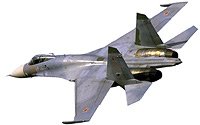See also Su-30 section
| Su-30MKK | KnAAPO produced Su-30MK for China with Su-27M vertical tails. Improved N001VE radar and IRST for the upgraded
fire control system with air-to-surface modes. Armaments include R-77, Kh-29T, Kh-59MK, Kh-31A, TV guided KAB series, R-27 and R-73 series. Reportedly designated J-13 in China. |  |
| Su-30MKI(?) | unofficial designation for the two MKKs types sold to Indonesia, not to be confused with Irkut's Su-30MKI for India.
|  |
| Su-30MK2 | Su-30MKK with upgraded electronics that enabled support for antiship
missiles. Upgraded radar called N001VEP. Also intended to work with SAPSAN-E and Kupol M400
reconnaissance pods. Delivered MKKs is expected to be upgraded to this standard. | |
| Su-30MK2V | Su-30MK2 variant for Vietnam with minor modifications.
Modifications include an upgraded communications suite and improved ejection seats. | |
Su-30MK2 AMV
Su-30MKV | Aviacion Militar Venezolana (AMV - Venezuelan Military Aviation)
version of the KnAAPO-produced Su-30MK2 for Venezuela. First delivered in December 2006. Also known as Su-30MKV. | |
| Su-30MK(?) | no official designation: Proposed Su-30MKK upgrade with NIIP Panda radar
(N001VEP + Pero phased array antenna). | |
| Su-30MK3 | Su-30MKK with Zhuk-MSE radar. Support for Kh-59MK antiship missile. Developed for or in cooperation with China,
reportedly cancelled due to dispute or concerns regarding technology/knowledge transfer. | |
| Su-30M2 | KnAAPO-built domestic version based on the Su-30MK2. Four aircraft ordered in 2007, delivered in 2011.
Reportedly new built aircraft from the Su-30MK2 production line | |
| Irkut-built Su-30 multi-role variants See also Su-30 section |
| Su-30MKI | Irkut produced export version for India with indigenous computers, French HUD Sextant
VEH3000, nav. sys Totem INS/GPS, MFDs and some Israeli systems (RWR and ECM),
first 32 built in Russia, first serial aicraft was flown
on 26 November 2000, and then shown at Aero India. Final assembly plus license production at HAL. See Su-27 operators: India | |
| Su-30MKM | Irkut produced version for Malaysia based on the Su-30MKI with significant avionics changes. Israeli-produced systems
are replaced by Russian- and South African-manufactured systems, with in particular ECM systems,
such as the MAW-300 missile approach warning system, LWS-310 laser illumination warning system,
SAAB Avitronics EWC electronic warfare controller. Also the Indian display processing unit of the Su-30MKI has been replaced by a Russian unit.
Furthermore the Thales Damocles LD/TGP has been integrated. | |
| Su-30MKA | Irkut produced version of its Su-30MK for Algeria. The Su-30MKA is similar to India's Su-30MKI
and Malaysia's Su-30MKM, but fitted with some alternative avionics. Like the Su-30MKM the French Thales Damocles
LD/TGP is being integrated. First two examples commenced flight-testing in August 2007.
Delivery of the first two aircraft started in December 2007 with official hand-over in January 2008. Sometimes
the aircraft are referred to as Su-30MKI(A) | |
| Su-30SM2 | IAPO-built domestic version based on the Su-30MKI. 40 aircraft ordered in 2012, to be delivered by 2015.
| |
| 5. Navalized Su-27K/Su-33 series: BACK TO TOP |
Su-27K/
Su-33 | navalized fighter version, airframe with canards, folding wing and
horizontal stabilizers, arrested hook, „navalized“ avionics, auto-landing systems,
retractable air refueling probe, can carry buddy container UPAZ-A Sachalin, 12 hardpoints. See Su-33 section |  |
Su-27KM/
Su-33M | planned navalized Su-27M / multi-role Su-27K. See Su-33 section | |
| Su-27KU | proposed training version (seats side by side), resulted in combat-capable Su-27KUB trainer development, see next. | |
Su-27KUB/
Su-33UB | navalized multi-purpose combat training version (seats side by side), new bigger wing with area 70 m2
(older 62 m2), wing span 16m (14,7m) with better aerodynamics (15-20% longer range with the
same amount of fuel), bigger canards and horizontal stabilizers, radar N010-27. One prototype built.See Su-33 section |  |
| Su-27KRC | proposed recon version of Su-27KUB | |
| Su-27KPP | proposed ECM version of Su-27KUB | |
| Su-33MK | proposed multi-role version of Su-27K for export, may have been revived for China several times before China's own J-15 was revealed, see entry further down. | |
| Su-33(?) | Designation unknown, proposed upgrade of the Su-33 based on the Su-27SM2.
Possibly also Su-33M. Because the Su-27SM2 is a gradual upgrade, might result in Su-33M2. Abandoned as Russian Navy will replace Su-33s with the MiG-29K. | |
| 6. Multi role Su-27M series: BACK TO TOP |
Su-27M/
Su-35 | upgraded airframe with canards, digital FBW, bigger radome and sting,
` higher vertical fins, 12 hardpoints, retractable air refueling probe, internal fuel
10250 kg, can carry 2 drop tanks each 2000 l, upgraded avionics, radar N011, rear
looking radar N012 in sting, full A-G capability, glass cocpit (3 –4 monochrome MFDs). Small first batch produced entered service for state tests, a few ended up with the Russian Knights team.
Offered for export as Su-35.
See Su-27M section For the current Su-35, see section #8 below. |  |
| Su-37MR | Proposed export version of the Su-27M with French avionics for UAE. Su-27M preproduction aircraft T10M-11 served as Su-37MR demonstrator. | |
Su-27MP/
Su-37 | ESA radar N011M, thrust vector control system, 4 colour MFDs See Su-37 section |  |
Su-27UM/
Su-35UB | Two-seat combat capable training version of the Su-27M aimed at export market to help Su-35 sales. One prototype built, first flown on August 7, 2000. Received
bort number '801'. Later fitted with Zhuk-MSE radar for testing. |  |
| 7. Bomber Su-27IB series: BACK TO TOP |
Su-27IB/
Su-32/
Su-34 | completely changed airframe, seats side by side, canards, bigger sting,
flat radome, main undercarriage with two tandem wheels, 12 hardpoints, ESA radar B004,
rear looking radar N012 in sting, new navigation sys., internal fuel 12 100 kg, max G
limit 7G, can carry 3 drop fuel tanks each with 3000 l/ 2400 kg fuel, titan armour used
on cockpit, some fuel tanks and partialy engines of weight 1480 kg, fixed geometry air
intakes, without air brake, without ventral fins, retractable air refueling probe, added
some stealth features and RAM, digital FBW, together 6 prototypes were built (2 used
only for ground tests). Currently in production for RuAF orders at NAPO. See Su-34 section |  |
| Su-27R | planned recon version of Su-27IB, probably the same equipment like Su-27KRC | |
| Su-27IBP | planned ECM version of Su-27IB, probably the same equipment like Su-27KPP | |
| Su-32FN | naval attack aircraft with SeaDragon FC system, MAD in place of N012,
acoustic search system , sono buoys in pods, missiles Kh-31, Kh-35 Uran, Kh-41 Moskit,
Yachont/Oniks, torpedoes, depth charges, rocket torpedos, prototype was T10V-5 introduced
in FN standard in Le Bourget 1995, but was probably equipped with basic avionics See Su-34 section |  |
| Su-32MF | proposed export version of Su-27IB See Su-34 section | |
| 8. 4++ Generation Su-35 series: BACK TO TOP |
Su-35
/Su-27BM | New Su-27 derivative (factory designation T-10BM) with redone airframe based on Su-27 basic design. Fitted with NPO Saturn AL-41F1 (izdeliye 117S) engines and improved avionics, including the new NIIP Irbis-E radar, to be built around a rotatable passive phased array. Unveiled at MAKS 2007.
First prototype designated Su-35-1 with bort number 901 first flew on February 19, 2008. Three more prototypes built, second flying prototype '902', static test airframe '903' and third flying
prototype '904'. '904' was lost during taxi trails prior to its maiden flight. Replaces the previous Su-35 effort with the T-10M/Su-27M series (which was designated Su-35 for the export market),
reusing the Su-35 designation. See Su-35 section | |
| Su-35S | Russian Air Force version of the Su-35 (T-10BM). Differs from the export Su-35 standard by having local IFF, EW, communication systems and Irbis radar with more advanced operating modes. 48 on order as interim fighter until PAK-FA, all to be delivered by 2015.
Series production at KnAAPO started in 2010,
with first series-produced Su-35S maiden flight on 5 May 2011. See Su-35 section | |
| 9. Chinese Flanker versions: BACK TO TOP |
| J-11/J-11A | Chinese designation for Su-27SK built by Shenyang under license. |  |
| J-11B | Chinese developed Flanker derivative based on the Su-27SK (J-11) with 70% Chinese produced
parts. Status unknown. Plans call for integration of the Chinese WS-10A turbofan. Possibly incorporating
avionics from the Su-30MKK. Reportedly being in production for the PLAAF. | |
| J-11BS | Planned two-seater version of the J-11B, probably to be developed from a Russian-supplied Su-27UBK
or Su-30MKK/MK2. | |
| J-15 | Shenyang built carrier-borne Flanker similar to the Su-27K (Su-33) for the Peoples Liberation Army Naval Air Force (PLANAF).
Structurally similar to the Su-33, reportedly fitted with Chinese avionics
developed for the J-11B including an anti-ship radar. Believed to have been first flown on August 31, 2009, with first simulated ski-jump take-off
on May 6, 2010. Two aircraft confirmed, believed to have entered initial limited production at No 112 factory. | |
| NATO (ASIC/ASCC) reporting names: BACK TO TOP |
| FLANKER-A | T-10 prototype |
| FLANKER-B | Su-27/Su-27SK (J-11) |
| FLANKER-C | Su-27UB/UBK |
| FLANKER-D | Su-27K/Su-33 (incl. J-15 now?) |
| FLANKER-E | Su-27M (Su-35, Su-37) |
| FLANKER-F | Su-27PU (Su-30), Su-30K/KN, Su-30M |
| FLANKER-G | Su-30MKK, Su-30MK2, Su-30M2 |
| FLANKER-H | Su-30MKI, Su-30MKM, Su-30MKA, Su-30SM2 |
| FULLBACK | Su-27IB (Su-32, Su-34) |
| Note: NATO reporting names are officially classified, but have often been "leaked". For more recent variants, they
are often based on guesswork by the aviation press [Parsh & Martynov, 2008]. [Webmaster: to my knowledge at least the last four in this list should be
regarded as unconfirmed/guesswork] |
| Sources: BACK TO TOP |
hide sources
view sources used
- AFM, 2007-2. Air Forces Monthly #227, February 2007, p. 5, Key Publishing, UK.
- AFM, 2008-2. Sukhoi Su-30s Presented to Malaysian Government, Air Forces Monthly #239, February 2008, p. 26, Key Publishing Ltd, UK.
- AFM, 2011-7. Flight-testing of Series Production Su-35S Commences, Air Forces Monthly #280, July 2011, p. 28, Key Publishing Ltd, UK.
- AFM, 2011-7. Chinese J-15 Carrier-Borne Fighter Revealed, Air Forces Monthly #280, July 2011, p. 33, Key Publishing Ltd, UK.
- Budack, W. (2004). Deutsche Suchoj Homepage, www.suchoj.com, Berlin, Germany.
- Butowski, Piotr (2008). Sukhoi's Latest 'Flanker', Combat Aircraft, European Edition, Vol.9, No.3, pp. 52-55, Ian Allan Publishing Ltd, UK.
- Cooper, Tom, et al. (2005). ACIG.org Forums, Austria. Last accessed on April 1, 2005.
- Fomin, Andrei (2000). Su-27 Flanker Story, RA Intervestnik, Moscow, Russia.
- Fomin, Andrei (2006). Flying the Red Star, Air Forces Monthly - August 2006, pp. 68-73, Key Publishing, UK.
- Fomin, Andrei (2007-6). Su-35 - a step away from the fifth generation, Take-off, June 2007, pp. 46-53, Aeromedia Ltd, Moscow. Retrieved from
www.sukhoi.org, last accessed on March 27, 2008.
- Fomin, Andrei (2007-9). Su-30MK Production Update, Air Forces Monthly #234, September 2007, p. 28, Key Publishing, UK.
- Fomin, Andrei (2007-11). Sukhoi's Su-35 Makes Its Debut, Air Forces Monthly #236, November, p. 20, Key Publishing Ltd, UK.
- Parsh, Andreas and Aleksey V. Martynov (2008). Designations of Soviet and Russian Military Aircraft and Missiles,
Designation-Systems.Net, Germany. Last accessed on August 25, 2008.
|
| Comment: BACK TO TOP |
|
Please send any corrections, updates or comments to webmaster@milavia.net
|
|
Copyright © 2008-2012 Niels Hillebrand - MILAVIA.NET
BACK TO TOP
|





 Back to Index
Back to Index